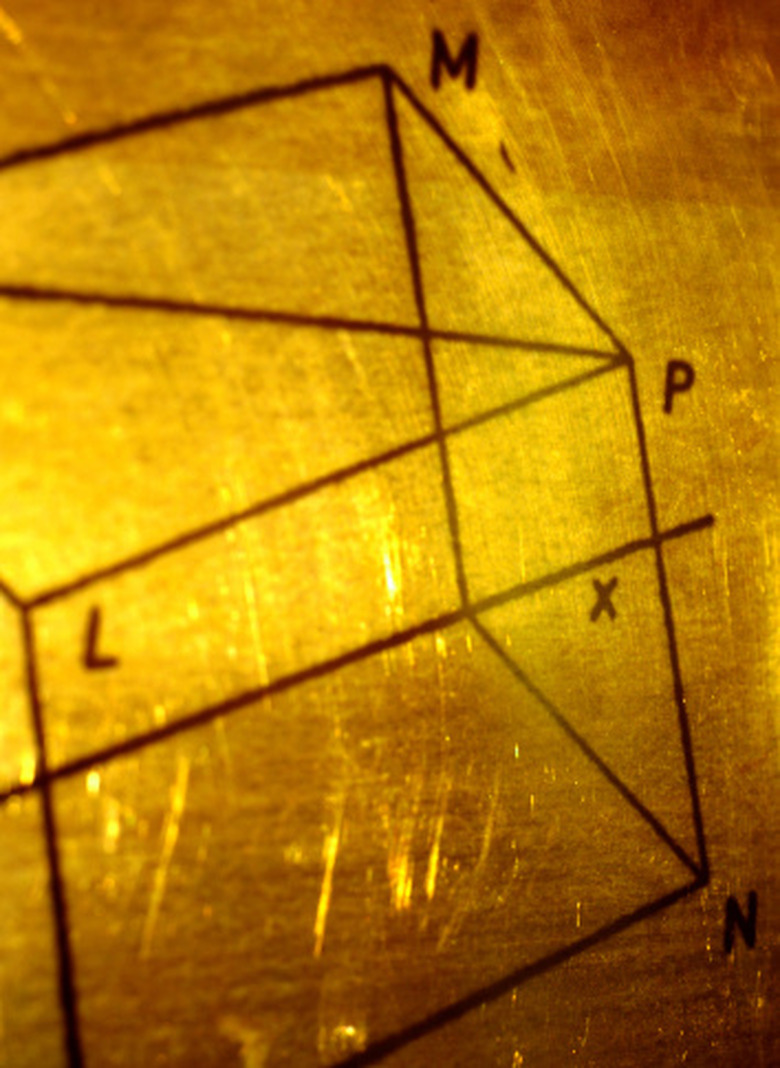How To Find The Volume & Surface Area For A Three-Dimensional Figure
Finding the volume and surface area of an object can be challenging at first, but with some practice becomes easier. By following formulas for different three-dimensional objects, you will be able to determine both volume and surface area of cylinders, cones, cubes and prisms. Armed with those figures, you will be well prepared for your next geometry test or for real-world application, such as craft or construction projects.
Rectangle and Square Prisms
Step 1
Measure the length, width and height of the square or rectangle prism or object in inches. Record each of these on paper.
Step 2
Multiply the three measurements together to find the volume using either paper and pencil or a calculator. This is the equation: Volume = length x width x height. For example, if the measurements of your prism are 6 inches, 5 inches and 4 inches, the equation would look like this: Volume = 6 x 5 x 4. So the volume would total 120 cubic inches.
Step 3
Determine the surface area of your prism using this equation: surface area = 2(length x width) + 2(length x height) + 2(width x height). You must complete the multiplication first, and then do the addition.
Step 4
Use the same example as before, plugging in the measurements to find the surface area: 2(6 x 5) + 2(6 x 4) + 2(5 x 4). Multiplication within parenthesis is the next step, so it would look like this: 2(30) + 2(24) + 2(20). Then complete the multiplication and addition: 60 + 48 + 40 = 148. The surface area equals 148 squared inches.
Cylinders and Cones
Step 1
Measure the height of your cylinder or cone and the diameter of its base in inches, using a ruler or tape measure, and record them. For a cone, height is measured not along the angle but from top to bottom at a 90-degree angle.
Step 2
Calculate the volume of a cylinder by dividing the diameter in half, which is the radius of the base. Multiply the squared radius by the height and by pi. The formula looks like this: volume = pi x radius squared x height. Radius squared is just (radius x radius), and pi is equal to about 3.14. If the radius was 9 inches and the height 20 inches, the formula would be 3.14(9 x 9)20 = 5,086.8 cubic inches.
Step 3
Find the surface area of a cylinder using the radius and height. The formula looks like this: surface area = 2(pi x radius squared) + 2(pi x radius x height). Using the same example as before, the equation would be: 2(3.14 x 9 x 9) + 2(3.14 x 9 x 20) = 2(254.34) + 2(565.2) = 508.68 + 1,130.4 = 1,639.08 squared inches.
Step 4
Determine a cone's volume with nearly the same formula as for a cylinder, except multiply the total by one-third. The equation looks like this: volume = 1/3 x pi x radius squared x height. If the height is 20 inches and the radius is 9 inches, the equation will be (1/3) x 3.14(9 x 9)20 = 1,695.6 cubic inches.
Step 5
Calculate a cone's surface area using a calculator and this formula: surface area = pi x r x square root of (radius squared + height squared). Using the earlier example, the equation would be: 3.14 x 9(√(9 x 9) + (20 x 20)) = 28.26(√81 + 400) = 28.26(√481) = 28.26(21.93) = 619.79 square inches.
Things Needed
- Ruler or tape measure
- Calculator
TL;DR (Too Long; Didn't Read)
Always double check your math to ensure you did not skip a step.
Cite This Article
MLA
Edrington, Allison. "How To Find The Volume & Surface Area For A Three-Dimensional Figure" sciencing.com, https://www.sciencing.com/volume-surface-area-threedimensional-figure-8671804/. 24 April 2017.
APA
Edrington, Allison. (2017, April 24). How To Find The Volume & Surface Area For A Three-Dimensional Figure. sciencing.com. Retrieved from https://www.sciencing.com/volume-surface-area-threedimensional-figure-8671804/
Chicago
Edrington, Allison. How To Find The Volume & Surface Area For A Three-Dimensional Figure last modified March 24, 2022. https://www.sciencing.com/volume-surface-area-threedimensional-figure-8671804/
